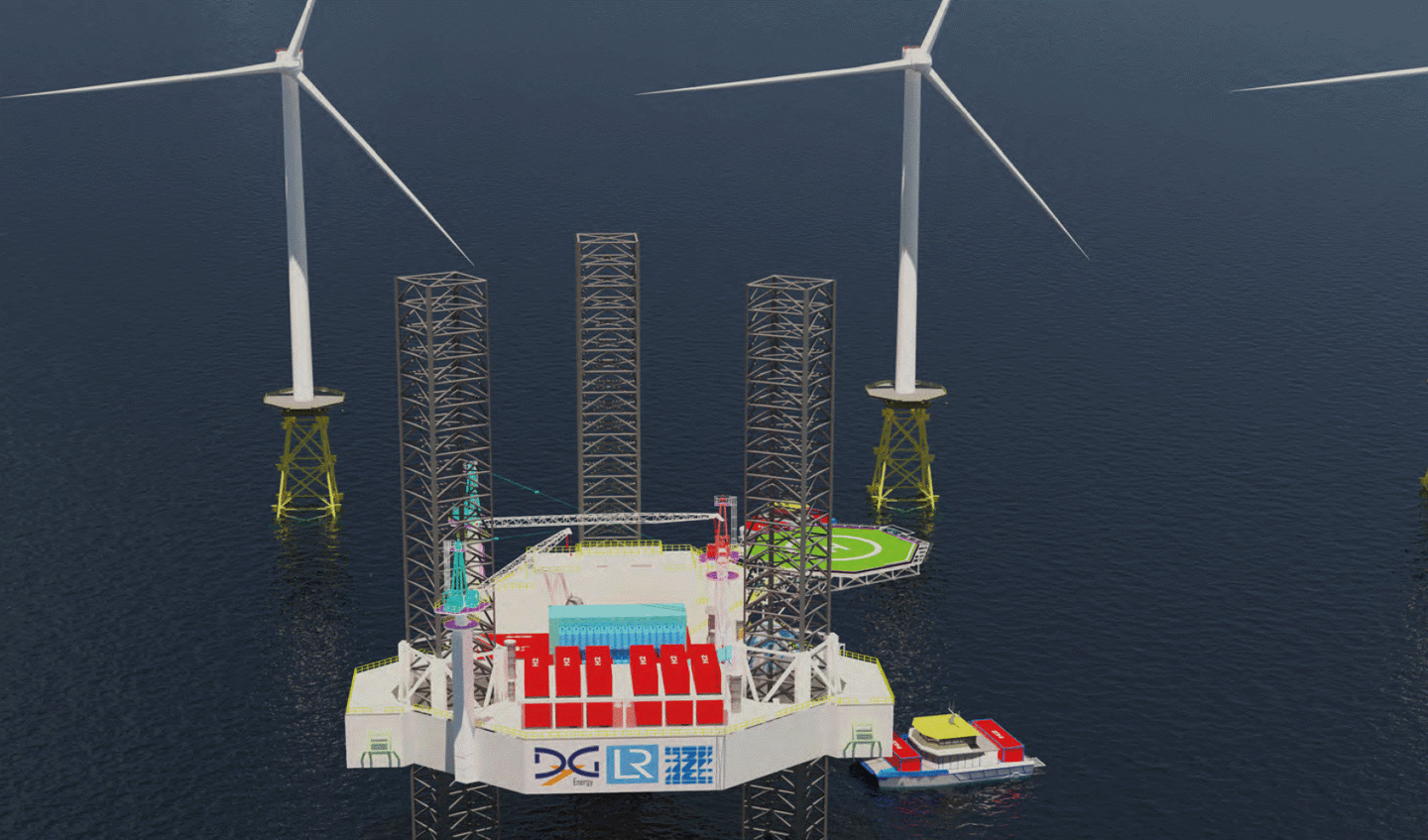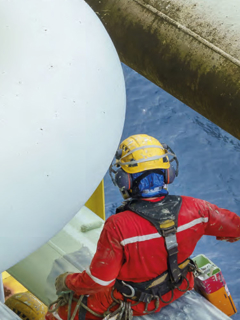The energy transition is impacting almost every industry and business as well as our day-to-day lives. The oil and gas sector is no exception and faces one of the biggest challenges with investors and regulators pushing for more sustainable operations. This is impacting the entire supply chain as it requires the conversion to low/zero carbon fuels and divestment into new energy segments.
At the end of 2020, the offshore industry saw drilling jack up utilisation rates as low as 62% according to Bassoe Offshore’s October 2020 report, showing a significant oversupply, and thus driving the uptake of recycling and conversion. Offshore drilling companies are looking at new business models and service offerings to transition into the era of low/zero-carbon fuels. One route being considered is the repurposing of existing infrastructure, leveraging offshore wind development and alternative fuel production required to achieve the International Maritime Organization’s (IMO) 2050 greenhouse gas (GHG) reduction targets.
Key considerations
As many readers will know, scrapping an asset takes a considerable amount of carbon and so, the mantra of ‘re-use being better than recycling’ is being put into practice. Owners may be able to attract more investors by repurposing existing assets, such as jack ups, as it will support the low carbon/zero-carbon fuel supply chain, creating a new stream of revenue as well as contributing to a sustainable maritime industry. This is not the only benefit of repurposing; this method also protects employment and retains critical offshore skills.
So, why a jack up? The marine environment is challenging and being able to limit the effect of the swell enables us to use a mature industrial solution without having to spend the money or time to design a specific system for floating assets. With the average life of a ship being roughly 25-30 years, the ships built today will last until 2050 and if they are not designed for low or zero carbon fuels, we lose 20-30 years of trying to reduce emissions, and we’ll also increase the overall carbon impact by having to half the lifetime of those assets.
That said, making such an investment requires asset investors to have confidence that there is a profitable and sustainable business model. Return on investment and carbon reduction should go hand in hand, meaning that operators must consider the through life cycle carbon impact of the project, so that the world’s net carbon position is improved and not worsened by the repurposing of these assets. Of course, if an operator or drilling company can repurpose an existing facility rather than build a completely new one, they will save both money and carbon.
Why hydrogen?
As the industry goes forward, there will be a move away from fossil fuel towards low and zero-carbon fuels so that the maritime sector can meet the IMO’s GHG 2050 goals. There are a number of diverse fuels available now, but these are not in a state and volume which can be used widely. Therefore, the industry needs to create a new ecosystem which can produce fuels such as ammonia, methanol, hydrogen and biofuel, with the lowest carbon footprint possible in various quantities and locations.
Safety, process and infrastructure are the biggest challenges facing the transportation and bunkering of these new fuels. If the industry starts with ecosystems, where production, distribution and consumption can be performed in a safe and controlled environment, this will then lead to expansion and wider uptake and thus accelerate the transition.
While the industry doesn’t know which fuel will take the lead in the zero-carbon race, we are seeing some governments and other stakeholders pushing for a hydrogen economy. This has led to the development of new technical solutions, which in turn has sparked confidence by investors and asset owners alike for a long-term and stable hydrogen market.
Before we jump ahead, we must ask ourselves if the industry is ready for this transition, and if the industry needs hydrogen as a fuel offshore. The answer may sit with the shipping industry; ships of all sizes are now being developed by shipbuilders and owners to use hydrogen as fuel. As the market develops, there is a clear need for collaboration between the offshore and marine industries to support the co-development of hydrogen production, whereby there’s a symbiotic relationship where both can grow and succeed.
What’s on the horizon?
To support the development of a hydrogen production ecosystem, DYG Energy has developed a concept for the first offshore hydrogen bunkering station, in which many of the industry’s existing jack up fleet could be repurposed to serve the hydrogen production market, supporting a sustainable and circular approach to hydrogen production.
The hydrogen jack up concept, known as MOPU, will be able to produce up to 3,000 tons of hydrogen per year from energy coming from a nearby offshore wind farm or other clean energy ocean-based alternatives. The MOPU concept will decommission the existing rig and upgrade it with robust, proven industrial electrolysers.
Wind farms are an obvious location to start with as it is a clean source of energy, with vessels operating on site and with the required water depth able to deploy units. DYG Energy’s facility would also be used as a maintenance base for wind turbine maintenance teams, this dual capability will allow optimised infrastructure costs as well as deliver a cost effective alternative fuel before 2026.
For the MOPU concept, hydrogen will be compressed and stored in container solutions enabling a fast transfer to vessels and mainly used for heavy mobility rather than storage due to its efficiency chain. Liquid hydrogen will be considered and developed at a later stage. In terms of water, the desalination process is already well known to the industry and can be easily scaled up for the required quantity of freshwater.
DYG Energy’s aim is to have the first unit in production by 2026, providing cost competitive hydrogen compared with standard marine fuel by using an innovative business model.
Project partners
DYG Energy’s project partners include Zentech Inc. and Lloyd’s Register (LR). Utilising more than 45 years of drilling expertise, Zentech Inc. has knowledge of all jack up designs and supports the accurate assessment of the structural health of the chosen asset and the feasibility to sustain leg fatigue for the desired time for specific locations. Together with LR, partners will assess safety and work together on the next generation of Rules that cover production, storage and transfer of hydrogen at sea.
DYG Energy, Zentech Inc. and LR are experienced in the offshore space with a deep understanding around how assets behave, both old and new. This collaboration will test and prove what is required, not just to develop such concepts but to also provide the basis for approaching regulators and other industry bodies. By doing this, partners can give confidence to the wider industry that MOPU can help meet IMO GHG goals in a safe way, building on the knowledge earned in the safety critical hydrocarbon industries.
Next steps
Going forward, the MOPU will be designed so it can be customised to accept shore power connection when countries, like Norway, have most of the country’s energy already decarbonised or can be integrated with other means of power generation, in the hope of delivering blue hydrogen for standalone units anywhere in the world.
DYG Energy is also looking to develop a network of hydrogen stations on European coasts to accelerate the access to low/zero carbon fuel. However, the current bunkering model will not work everywhere and like electric vehicles, which can now be recharged at home or at work, we may see a future whereby we can bunker our ships at sea instead of ports.
Innovation in offshore
LR’s Offshore Technology Manager, Mark Tipping explores previous innovations in the offshore market, parallels and some of the challenges around jack up conversions.
Innovation is not new to offshore. The repurposing of oil tankers into FPSOs was as challenging as the new opportunities coming through today, after all ships were never designed to ride out the harshest of environments while on station, something we now see as normal with FPSOs. The permanent siting of jack ups for long-term operation in one location has its parallels to the first FPSOs, whereby there are challenges and opportunities that must be explored.
The repurposing of jack ups to permanent fixed installations, coupled with the integration of hydrogen production plants, brings new challenges to the offshore industry. The first priority when repurposing jack ups is to ensure their long-term safety in a fixed position. The traditional design of jack ups is based on their temporary deployment, so making sure that the maintenance of the structure and the jacking mechanism is easy to achieve, as well as reducing the likelihood of significant issues caused by scour around the jack feet. With this in mind, deploying a jack up for a longer period of time, combined with determining the criteria that needs to be applied to meet safety concerns with respect to harsh metocean conditions, as well as the long-term exposure of the legs in the marine environment, are all challenges that need to be considered.
As it stands, the industry has no large-scale experience of the deployment of hydrogen production systems, meaning the safety of production and offloading systems need to be carefully considered with respect to process safety, long-term exposure to the marine environment and the ability to safely offload hydrogen in a range of sea and wind conditions.
Over the years, LR has supported clients with new and innovative approaches and technologies in the offshore sector, from the first North Sea Jacket production systems to the first FPSOs, through its range of services in risk, engineering assurance and compliance.







